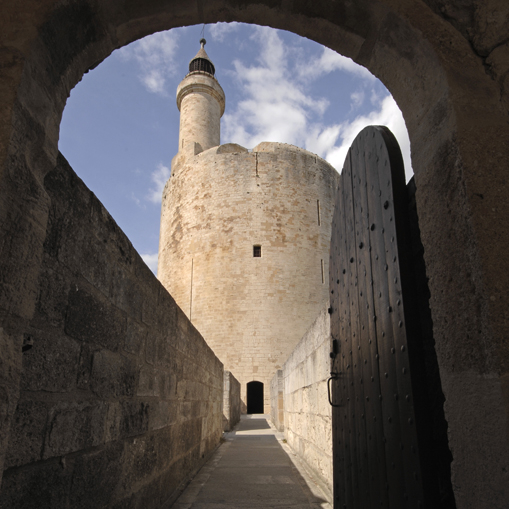A must-see
article | Reading time3 min
A must-see
article | Reading time3 min
To find out all you need to know about the towers and ramparts of Aigues-Mortes, start your visit at the brand-new mediation area in the Governor's lodgings! We'll show you around?
Climb the staircase overlooking the main courtyard to reach the second floor and the introductory rooms.
On the second floor, four rooms present key themes in the city's history, including:
© David Bordes / Centre des monuments nationaux
Let Saint Louis guide you!
An immersive projection places the creation of the city in the geopolitical context of the South of France, and explains the founding acts that accompanied the birth and prosperity of the city.
© Thomas Rothé / Centre des monuments nationaux
Right from its foundation, Aigues-Mortes was one of the major ports frequented by Italian merchants in the 13th century. It became a veritable crossroads for the exchange of goods, techniques, culture and ideas. It's likely that Louis IX had already envisaged the commercial development of the town he had just founded.
However, the commercial destiny of Aigues-Mortes took on a new dimension under the reign of Philip III the Bold, who in 1278 succeeded in establishing Aigues-Mortes as the kingdom's sole access point for maritime trade. The city thus became the main point of entry and exit for the kingdom's goods.
Six model ships represent the main vessels of the 13th century, sailing on the high seas and the river and sea networks of the Mediterranean coast. A projection shows the ships in the bay of Aigues-Mortes and the town's port system, while an interactive touch table details the long preparations, the king's eventful journey on the seventh crusade, and the eighth - and final - crusade that proved fatal.
© Thomas Rothé / Centre des monuments nationaux
An audiovisual show featuring video mapping on models and screens presents the urban development of Aigues-Mortes. In an animated film, you'll discover the main issues surrounding salt and its harvest. Indeed, the salt trade continued to expand, with 16 saltworks in the 14th century.
Finally, a large timeline retraces the major episodes in the region's religious conflict, and the important role of Aigues-Mortes as a Protestant stronghold that became a Huguenot prison.
© Thomas Rothé / Centre des monuments nationaux
Before continuing with a tour of the ramparts, a 3D digitization of the fortifications presents the military architecture and a tactile model of the defensive system.
© Thomas Rothé / Centre des monuments nationaux
The entire tour is translated into English and German.
All audio-visual devices are available in French sign language, to ensure the tour is accessible to the deaf and hearing-impaired. The tour is also accessible to people with reduced mobility and the visually impaired, with voice-over narration of the audiovisual devices in rooms 1 and 3, and tactile models to help visitors understand the fortified enclosure and its structures.
© Benjamin dIngrando / Centre des monuments nationaux
© David Bordes / Centre des monuments nationaux
© Benjamin dIngrando / Centre des monuments nationaux
© Thomas Rothé / Centre des monuments nationaux
© Thomas Rothé / Centre des monuments nationaux
© Thomas Rothé / Centre des monuments nationaux
© Thomas Rothé / Centre des monuments nationaux
© Benjamin dIngrando / Centre des monuments nationaux















